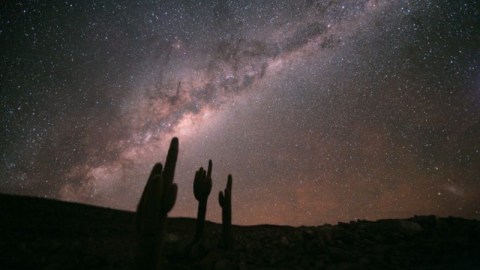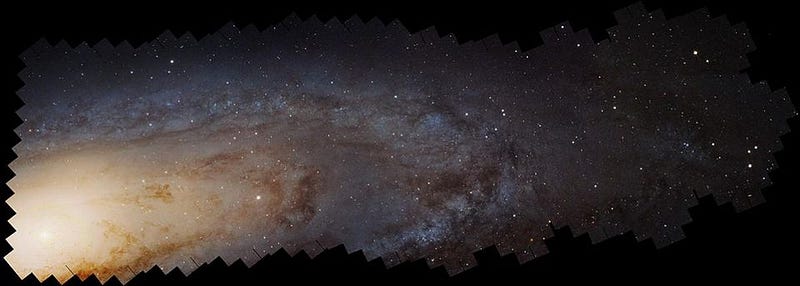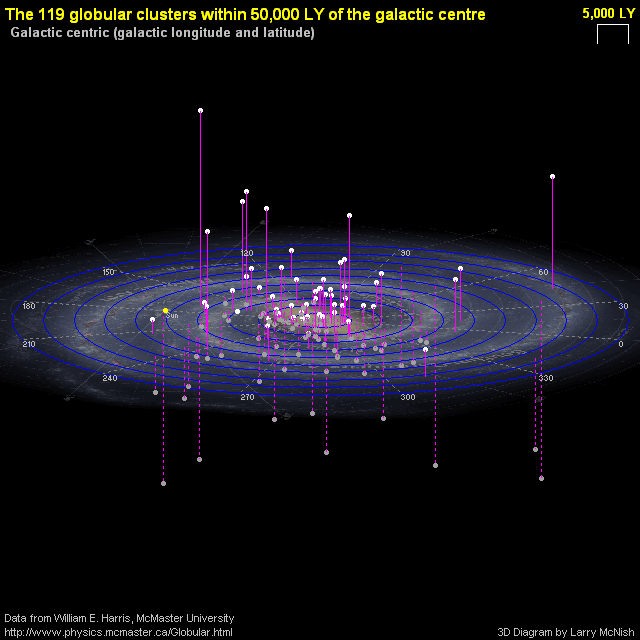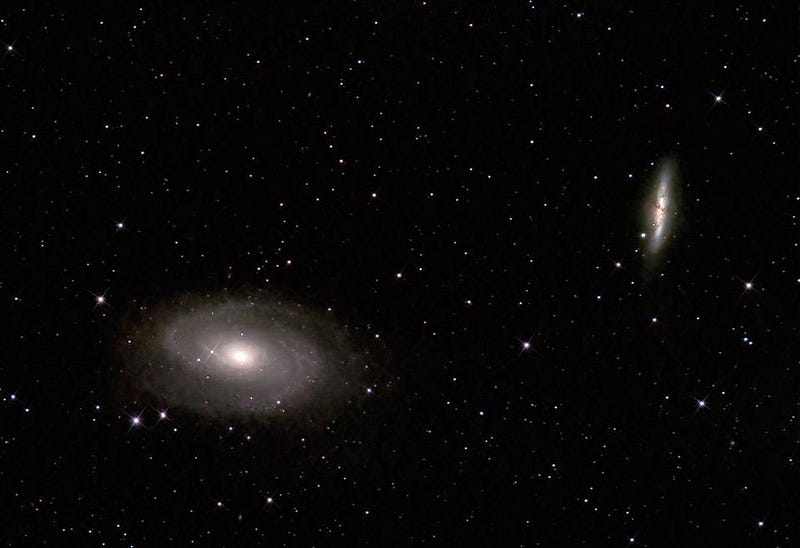Could The Milky Way Be More Massive Than Andromeda?

The only other large galaxy in the local group is larger in size and has more stars. But mass? Perhaps we’re the biggest, after all.
The Milky Way is home to the Sun, our Solar System, and hundreds of billions of stars beyond that. Yet unlike all the other galaxies out there — in our Local Group and in the Universe beyond — we have no good way to view our own galaxy from our position within it. As a result, the full extent of our galaxy, including its total size, mass, matter content, and number of stars, remains mysterious to modern astronomers.
We’ve long looked at the galaxies surrounding our local neighborhood in space and compared ourselves to them. Although there may be more than 60 galaxies present within the Local Group, two of them dominate in every way imaginable: ourselves and Andromeda. We are the two largest, most massive galaxies around, with more stars than all the others combined. But which one is bigger? Long thought to be Andromeda, we’re now finding out the Milky Way might have a chance at being number one.

It might strike you as a tremendous failing on the part of astronomers that we haven’t yet learned how big, massive, or full of stars our own galaxy is, but it shouldn’t surprise you. Think about it from another point of view: imagine you were looking out at a room of people, and you wanted to determine what everyone’s eye color was.
It seems like the easiest experiment of all. All you’d have to do is get close enough to everyone in the room to see what color their eyes were, and you’d know. You’d likely know the eye color of everyone close to you right away, and through use of a tool — a camera, a pair of binoculars, a telescope, etc. — you could determine the eye color of everyone within your view. There’d only be one person in the room who’d give you trouble: yourself.

We have two ways of determining our own eye color from within our own bodies.
- We can shift our perspective outside of our own bodies. Either by asking another person in the room or by taking a selfie, we can learn what the results are and gain the missing data point of our own eye color.
- We can find an accurate-enough reflection, and learn what our eye color is from this light-echo we’re observing.
For our own bodies, this is easy enough. Many trustworthy external observers exist; camera technology is advanced, accurate, and ubiquitous; reflective surfaces like mirrors, glass, or even bodies of water are abundant. When we’re not in isolation, and live in a world with the right tools, it’s an observation that’s easy to make.

But what if the right tools weren’t readily available to you? What if there was no one else outside of your own body that you could contact and whose observations you could rely on? What if there were no reflections of your own face that you could look at and view yourself to determine your eye color? And what if there was no way to take an indelible image of yourself (e.g., a photograph), enabling you to view your likeness?
It’s a hard problem. Being embedded within your own body means there’s no good way to take the critical observations yourself without the outside world around you cooperating. Well, being embedded within the Milky Way means that even our best views of our own, home galaxy from within it have fundamental limitations. We might be able to measure the motions and positions of billions of stars, but there’s still so much that’s obscure.

Being located in the plane of the Milky Way, 25,000 light-years from the galactic center, means that there are a number of things we cannot view optically.
- Most of the stars in the galaxy, since the dust in the plane of the Milky Way (or other structures, like nebulae or stars) obscures it.
- The bulk shapes that are traced out; we still argue about the number and size of the spiral arms, the presence or absence of arm spurs, the age and extent of the central bar, etc.
- The number and location of recent supernovae and supernova remnants, since the far side of the galaxy cannot easily be seen.
- And the transverse motions of the stars as they move around the galaxy; because we’re located in it, measuring bulk rotational motion as a function of galactic radius is challenging.

Multi-wavelength views are helping, as infrared light of various wavelengths is more transparent to the dust, and large-scale sky mapping observatories from both the ground and in space — particularly ESA’s Gaia mission — are helping us understand the full extent of the physical properties of our galaxy.
Andromeda, on the other hand, is very close by at just a little over 2 million light-years distant. It is the largest galaxy beyond the Milky Way in terms of angular size, or the amount of space it takes up on the sky. We have engaged in a number of spectacular observing campaigns of Andromeda, most notably PHAT: the Panchromatic Hubble Andromeda Treasury, which measured and characterized the stars and dust across nearly half of our giant cosmic neighbor.

When we hold these two galaxies up against one another, comparing our own Milky Way to Andromeda, we find there are some stark differences that suggest Andromeda is the more dominant of the two.
- When we count the number of stars, the (infrared) Spitzer Space Telescope showed that Andromeda has approximately 1 trillion stars inside it, compared to a much smaller number with much larger uncertainties — between 200 billion and 400 billion — for the Milky Way.
- In terms of physical extent, the Andromeda Galaxy’s disk diameter is well-measured, and spans 220,000 light-years across. For comparison, the diameter of the Milky Way’s disk has long been thought to be only about half that: around 100,000 light-years.
- And in terms of the stars present, the Andromeda galaxy’s stars are much older, and its star-formation rate is much lower: only about 20–30% that of the Milky Way.

So you’d probably think, if you went and measured the mass of these two galaxies, you’d find that Andromeda would be far greater in mass than the Milky Way. But this isn’t the case at all.
You see, the best way to measure galactic mass is by using the stars and globular clusters found distributed far away from the galactic center or disk: in the galaxy’s halo. Doing this for a galaxy like Andromeda is fascinating and educational, teaching us that the massive halo extends for approximately a million light-years in all directions, and contains a large amount of mass in this halo as well, in terms of both gas and dark matter. Although there are large uncertainties, the total mass estimates of Andromeda range from about 800 billion solar masses up to 1.5 trillion solar masses. These estimates are so different because they’re arrived at by using different techniques, which poses an interesting puzzle at present.

By measuring the motions of globular clusters within our own Milky Way, however, we don’t have to rely only on the radial (along our line-of-sight) measurement, but can obtain transverse (moving perpendicular to our line-of-sight) motions as well. A combination of new data from the Gaia mission and the Hubble Space Telescope has given us a total of 46 globular clusters with distances reaching as far as 130,000 light-years from Earth, and was able to pin down the Milky Way’s mass more accurately than ever before.
The result?
The Gaia data alone indicates a mass of 1.3 trillion solar masses, while the combined Gaia/Hubble data (where Hubble captures the more distant globular clusters) yields a mass of 1.54 trillion solar masses, with an uncertainty of less than 100 billion solar masses.

In other words, even though the stars tell a different story, the overall mass shows that the Milky Way is likely as massive as the most massive estimates for Andromeda. If the radio observations of Andromeda is correct, our galaxy may even be nearly twice as massive as Andromeda.
What’s even more interesting is that another recent study, published last year to very little fanfare, indicates that the extent of the Milky Way’s disk may be much larger than previously estimated: more like 170,000 light-years in diameter, rather than 100,000 light-years. Summing it all up, it looks like the Milky Way may be larger in extent and more massive in nature than we realized, while Andromeda may be more diffuse, spread-out, and less massive than we previously suspected.

For a very long time, our observations of Andromeda and the Milky Way seemed to indicate that we were second to Andromeda in pretty much every way as far as our local neighborhood was concerned. But the real thing that’s changing is our measurements are improving, and we’re learning just how difficult it is to accurately measure total mass values even in our own backyard. We’re understanding and quantifying our uncertainties, and are realizing just how significant they are.
There are stellar streams, ancient and recent gravitational interactions, and unknown initial conditions and past histories for every galaxy in question. When we measure these stars and clusters, we are only measuring velocities, yet to understand total mass, we want to measure accelerations, and that’s where the difficulty lies. It’s very much possible that our Milky Way is as massive or even more massive than Andromeda. As always, it will take more and better science to uncover the final answer.
Ethan Siegel is the author of Beyond the Galaxy and Treknology. You can pre-order his third book, currently in development: the Encyclopaedia Cosmologica.





